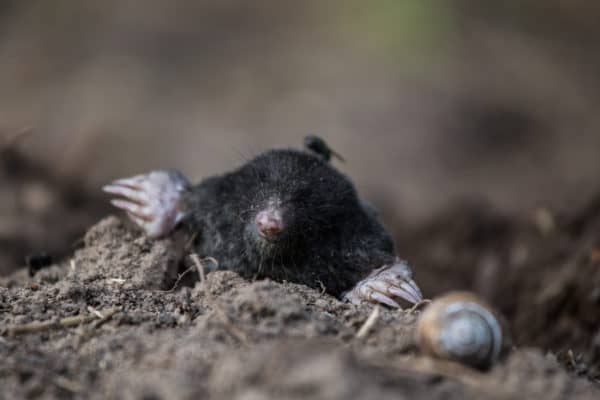READY TO GET STARTED?
REQUEST A FREE ESTIMATE
Fill out the form below or call (888) 466-7849 for a free, no-obligation estimate.

A very common misconception is that moles hibernate during the winter. This is, in fact, not true. Moles do not hibernate and are quite active during the winter months. They actually remain active all winter long, continuing to dig and eat voraciously. Moles are omnivores that prefer to feast on grubs, earthworms, and other bugs. As the soil freezes, moles move from tunneling near the surface to digging deeper in the ground. When the weather starts to warm, the moles will tunnel closer and closer to the surface as the soil thaws and becomes easier to navigate.
Moles can wreak havoc on your lawn and garden. Moles cause dead grass patches because their tunneling disrupts the root system of grass. This creates patches that often start out yellow and eventually turn a light tan color. They also push soil and grass up as they dig, creating random mole hills across your yard. While these are easy to spot in the summertime, they can often go undetected in the winter months, giving you less opportunity to identify and eliminate them early. Because of this, it is important to take precautionary measures early before the winter season sets in. Here are some steps you can take for mole prevention this winter.
Overuse of sprinklers and irrigation systems can lead to saturated, loose soil – an ideal environment for moles. This loose soil is much easier to tunnel through and is often rich with earthworms and grubs, making it a literal feast for moles. Heavy rainfall can also create these conditions so it is important to be vigilant after storms. Limit watering unless necessary.
Mulch is a very effective insulator for plants during cold weather. While we are usually inclined to go ahead and mulch before the cold weather sets in, this creates an insulated environment for moles, as well as your plants. Instead of installing mulch in early fall, try to wait until after the first frost. Hopefully by that point, moles and other pests have established themselves in a more hospitable environment than in your yard.
Physical barriers can be very effective at preventing more damage to flowerbeds and trees. These barriers can be in the form of hardware cloth liners in the bottom and sides of flowerbeds or across the top of the bed to prevent digging or wrapped around the base of trees. By preventing them from digging you can limit the damage inflicted and hopefully encourage them to move on to another yard.
Cats, snakes, and birds of prey are the most common natural predators of moles. Cats are especially notorious for pest prevention and rodent control around properties. If you don’t already have a cat, you may consider adopting one to roam your property and provide you with free pest control. Although it may be difficult, reconsider killing that snake you find on your property as they are also excellent at controlling rodent and other pest populations.
As mentioned above, moles prefer to feed on earthworms, grubs, and other insects. In fact, mole problems often arise because of underlying grub problems. Be proactive in eliminating grubs and other pests from your yard to help control mole populations, as well.
The cliche of “making a mountain out of a mole hill” isn’t far from the truth. Mole problems can manifest quickly into mole infestations and they can be extremely difficult to control and eliminate. Consider contacting a professional pest control company and setting up ongoing pest control services as these scheduled visits can help identify mole problems early and help resolve your mole issue quickly.
5 Reasons To Be Thankful for Pest Control
Things That Go Bump in Your Crawlspace
Categories